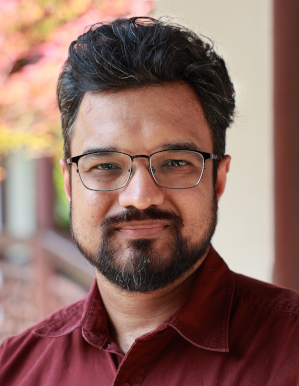
| Professor Mithun Mukherjee, Nanjing University of Information Science and Technology, ChinaIEEE Senior MemberMithun Mukherjee is a university-appointed Professor with the School of Artificial Intelligence, Nanjing University of Information Science and Technology, Nanjing, China. He was a specially assigned researcher and assistant professor with the Guangdong Provincial Key Laboratory of Petrochemical Equipment Fault Diagnosis, Guangdong University of Petrochemical Technology, Maoming, China, from 2015 to 2020. His research interests center around the Internet of Things, mobile edge computing, Tactile Internet, and ultra-reliable low-latency communications. He has (co)authored more than 120 publications in peer-reviewed international transactions/journals and conferences. He has two highly cited ESI papers with Google Scholar citation 2500+, h index 18 and I10 index 34. He was listed in Stanford University's 2020 top 2% of scientists in the world (top 0.5% in CS/network). He has one granted Chinese patent. Dr. Mukherjee was a recipient of the 2016 EAI WICON, the 2017 IEEE SigTelCom, the 2018 IEEE Systems Journal, and the 2018 IEEE ANTS Best Paper Award. He has been a guest editor for IEEE Internet of Things Journal, IEEE Transactions on Industrial Informatics, ACM/Springer Mobile Networks and Applications, and Sensors. He is a regular reviewer/lead guest editor for many prestigious journals and conferences, serves as the TPC member/chair for various conferences, and organized many special sections/workshops in prestigious international conferences. He completed his Ph.D. from the Indian Institute of Technology Patna, Patna, India, in 2015. He is a senior member of IEEE and a member of CCF. Professor Tang Liu, Sichuan Normal University, ChinaTang Liu is a Professor,Vice Dean, and Ph.D. supervisor at the College of Computer Science, Sichuan Normal University. His research interests include the Internet of Things, mobile computing, and wireless charging. In recent years, he has published over 60 papers inprestigious conferences and journals such as INFOCOM, ICDCS, IPDPS, IEEE/ACM TON, IEEE TMC, ACM TOSN, IEEE TWC, IEEE TCOM, Chinese Journal of Computers, and Journal of Software, including 15 papers in CCF-A conferences and journals. He has served as a PI for over 10 research projects, including two by the National Natural Science Foundation of China. He is also a reviewer for several CCF A/B journals and serves as a chair or program committee member for several international academic conferences. Speech Title: Advances in Efficient Wireless Rechargeable Networks Abstract: With the maturation of wireless powertransfer technology, Wireless Rechargeable Networks (WRNs) have attracted widespread attention from both academia and industry. However, the inevitable attenuation of radio waves during transmission and environmental interference have made charging efficiency a major bottleneck limiting the development of WRNs. In this talk, I will present our team’s recent research efforts aimed at improving wireless charging performance and building efficient WRNs. These efforts include: (1)Utilizing the neglected back lobe for improving charging efficiency; (2) Designing dynamic power controlling scheme to meet real-time charging demands; (3) Developingwave interference-based safe charging scheme to ensure electromagnetic radiation safety for sensitive individuals; (4) Enhancing charging performance by exploiting the multipath effects caused by environmental objects. Associate Professor Lei Chen, Shandong University, ChinaHe is a recipient of the Shandong University Young Scholars Future Program and a member of the Chinese Association of Automation. His primary research interests include image processing and computer vision, visual quality assessment and image enhancement, abnormal behavior analysis, digital watermarking, as well as machine learning and artificial intelligence. Dr. Chen currently leads multiple research projects funded by the National Natural Science Foundation of China, key subprojects under the National Key Research and Development Program, the Natural Science Foundation of Shandong Province, and the China Postdoctoral Science Foundation, among others. He has also participated in projects funded by the Canadian Natural Sciences and Engineering Research Council. To date, he has published numerous papers in prominent international journals and conferences, holds several national invention patents, and serves as a reviewer for leading international journals as well as a session chair for international conferences. He has been invited multiple times to deliver keynote and invited talks at international conferences. Speech Title: Deep Learning for Abnormal Behavior Detection and Action Localization Abstract: In recent years, the video surveillance systems are widely used in the fields of urban safety, security management, crime-fighting, and healthcare. The research on abnormal behavior and action localization is crucial to maintain safety and improve the quality of life. However, surveillance environments often present severe conditions, such as fluctuating lighting, the presence of shadows, and adverse weather conditions. These background variations introduce noises for human behavior features and degrades the abnormal behavior detection and action localization performance. To address these problems, we propose a new framework called efficient abnormal behavior detection that simultaneously integrates spatio-temporal feature modeling and long-term dependency modeling. And we design a multidimensional path aggregation network for spatio-temporal action location, which aggregates the features of multiple paths and fuses the corresponding hierarchical features to obtain spatio-temporal behavioural features. The experimental results show the effectiveness of our proposed methods and demonstrate superiority over other related methods. The research findings can be used to identify and intervene in potential threats, accidents, and dangerous situations. |


